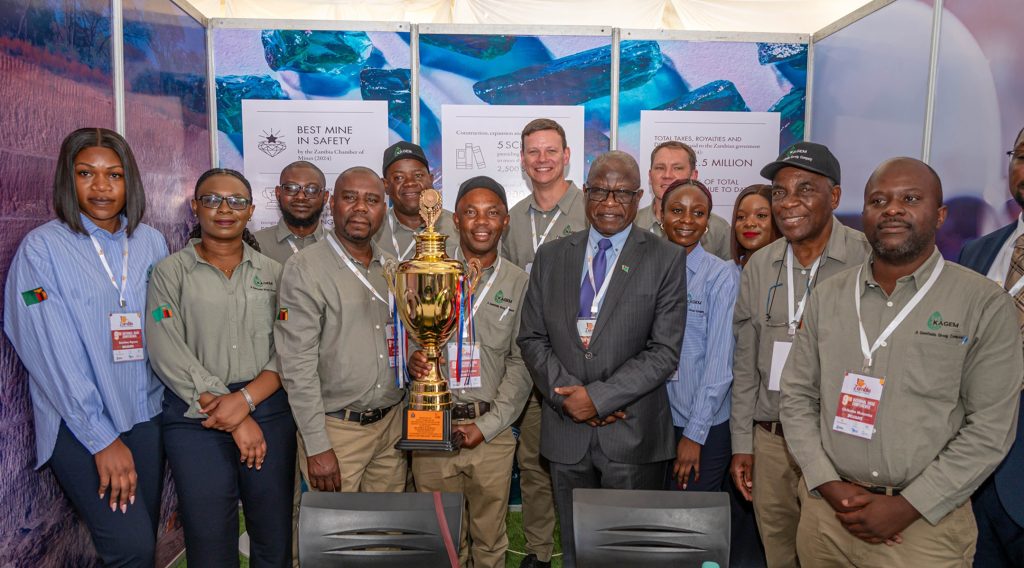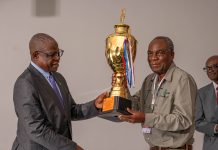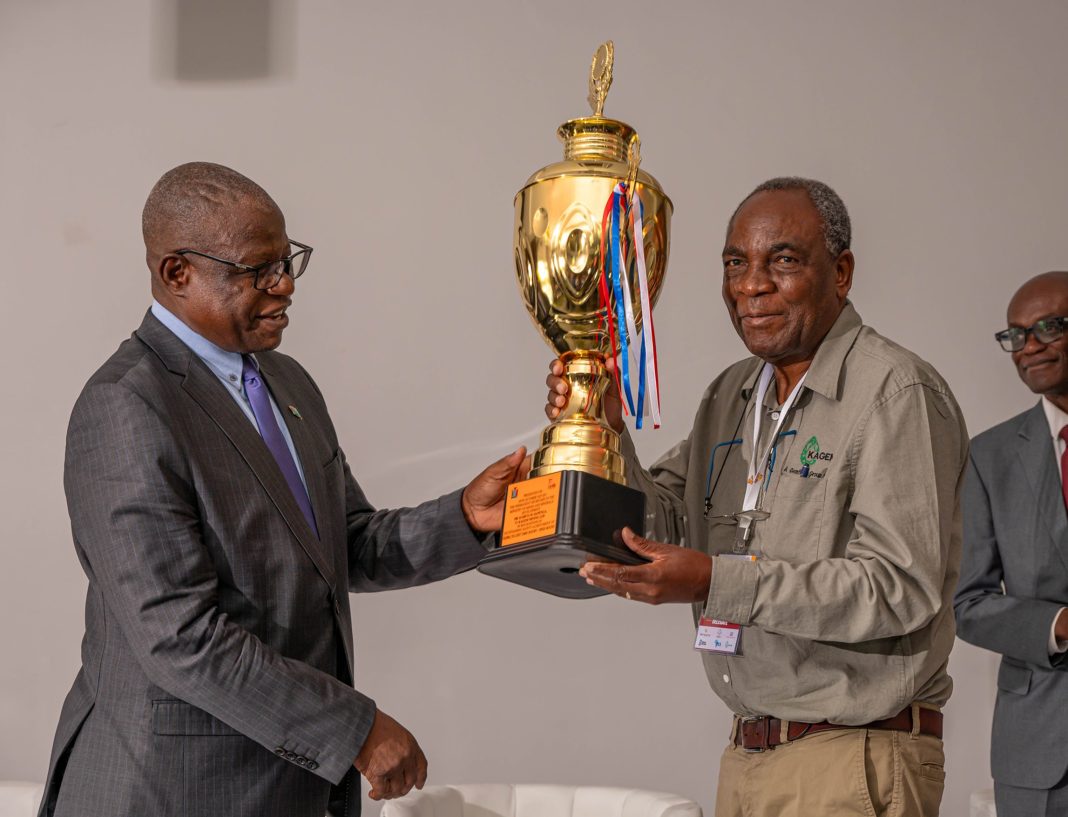For the second year running, Kagem Mining Limited has been named Zambia’s “Best Mine in Safety.” In an industry known for its operational risks, receiving this recognition two years in a row is no small feat for the Lufwanyama-based emerald miner.
The award was presented at the 9th National Conference on Occupational Health, Safety and Environment (HSE) in Ndola by the Permanent Secretary at the Ministry of Mines and Minerals Development, Dr Hapenga Kabeta, on 30 October.
It follows another milestone in May this year, when Kagem was recognised by the Mines Safety Department for achieving over 10 million Lost Time Injury (LTI)-free hours. ‘LTI-free hours’ is a key safety metric in the mining sector that tallies the total number of hours worked by all employees and contractors without a work-related injury that’s serious enough for someone to miss their next full shift or workday. Since May, Kagem has surpassed 11.5 million LTI-free hours.
But this award is not just about numbers, or how safety is measured year by year.
A shared vision for ‘zero harm’
“Striving for a ‘zero harm’ culture goes beyond safety records,” said Chairman of the Board at Kagem, Dr Sixtus Mulenga, who received the award along with Mr Adriaan Prinsloo, General Manager at Kagem. “Every day without incident is something to be grateful and proud of,” he added.
The goal of ‘zero harm’ was formalised at last year’s national HSE conference, when Government stakeholders launched the ‘Vision Zero’ initiative for the mining industry in partnership with the Zambia Chamber of Mines, the Africa Vision Zero Network, and the International Social Security Association (ISSA). ‘Vision Zero’ is part of a global prevention strategy – championed by ISSA – that aims to eliminate work-related fatalities and serious injuries by promoting a culture of prevention and systemic safety interventions.
Speaking at the HSE conference, Kagem’s Head of Health, Safety, Environment and Quality, Mr Benedict Bukoka said: “At Kagem, we believe that the adoption of Vision Zero and a ‘zero harm’ culture in mining will continue to change the trajectory and perspective of safety and health in Zambia’s mining sector for the better.”

Collaboration that saves lives
The theme of this year’s conference was “Innovative Solutions to Zero Harm: Technology and HSE” – emphasising the fact that automation, monitoring tools, and data-driven risk assessment are becoming essential to modern mining.
“Achieving and sustaining this goal will require the deployment of every tool available to us, including existing and emerging technologies – as highlighted at this year’s conference,” said Mr Bukoka.
He also applauded the coming together of the mining community to exchange knowledge that improves workplace safety.
One such collaboration took place in December last year when mine rescue teams from ten leading Zambian mining companies came together for a first-of-its-kind joint training session hosted at FQM’s Kansanshi Mine. The purpose? To strengthen mine rescue standards across the country by sharing expertise and aligning safety protocols.
Importantly, these collaborations extend beyond mine gates. When accidents occur in surrounding communities, mine rescue teams are often the first responders. Enhancing their capacity strengthens not only the mining workforce’s safety net but also that of the broader community.
Beyond compliance
Across Zambia, mining companies are shifting from compliance-based safety systems to more participatory, behaviour-based approaches. At First Quantum Minerals’ Kansanshi and Trident operations, for example, the THINK! programme trains employees to assess risks, identify hazards, and make safe decisions in real time. It’s a simple but powerful reminder that safety begins with individual awareness:
T – Take the time
H – Highlight the hazard
I – Identify what could go wrong
N – Necessary actions to be taken?
K – Keep safety first!
Kagem’s outstanding safety record and FQM’s behaviour-based approach are both examples of an emerging trend: safety is becoming a shared mindset that mines are investing in – rather than a checklist.
A sector that’s raising the bar
Speaking as Kagem’s Chairman of the Board, Dr Mulenga said: “This achievement reaffirms our commitment to safeguarding the health and safety of every individual at our mine site and operations, and is testament to our culture of striving for continuous improvement.” He added, “We do not take such milestones lightly nor for granted in our industry, as the health and safety of our employees is our highest priority.”
Dr Kabeta pointed out that promoting safety within the mining industry is not only “a moral and legal obligation.” It’s also “a key driver of sustainable development and investor confidence,” he said during the award presentation.
“I wish to reiterate the government’s commitment in fostering a safe, sustainable, and technologically driven mining and industrial sector. We will continue to support initiatives that promote the best in health, safety, and environment management while ensuring that we strengthen regulatory frameworks and enhance collaboration among stakeholders. Through these efforts, Government aims to achieve the vision of ‘zero-harm’ where every worker operates in a secure environment and ensures that mining activities contribute meaningfully to the national development while sustaining lives, communities and the environment,” he added.
Kagem’s recognition as the “Best Mine in Safety” for the second consecutive year is more than a stand-alone success story. It reflects the fact that the sector is learning and evolving together. From collaborative training to behavioural safety and digital innovation, Zambia’s mines are taking action around a shared belief: that safety and productivity reinforce one another.
***
See also: Safety is a year-round commitment























